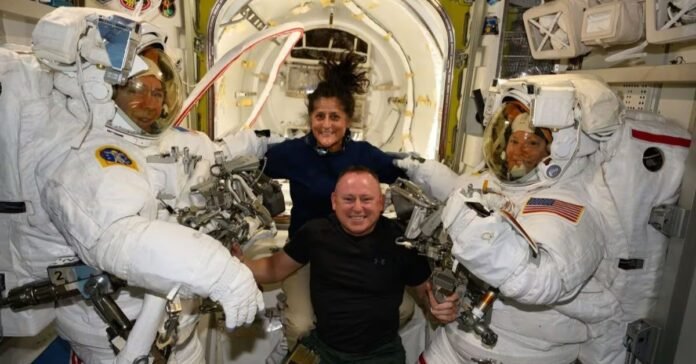
Imagine living in a floating laboratory, 408 kilometers above Earth, where sunrise and sunset occur every 90 minutes, and gravity is a thing of the past. This is the daily reality for astronauts aboard the International Space Station (ISS), a marvel of human engineering and international collaboration. Built by NASA, ESA, Roscosmos, JAXA, and the Canadian Space Agency (CSA), the ISS has served as a home for astronauts for over two decades, playing a crucial role in shaping the future of space exploration.
Why Do We Need the ISS?
“The basic reason for having the space station is to understand the possibilities of human survival on the Moon and Mars,” explains Rachna Arora, a Physics Educator at Shiv Nadar School. The ISS also enables research on how microgravity affects human biology and the potential for growing crops in space, key elements for long-term space missions.
The Unexpected Stay of Butch Wilmore and Sunita Williams
Astronauts Butch Wilmore and Sunita Williams were set for an eight-day mission aboard the Boeing Starliner (CST-100), a spacecraft designed for crew transport. However, their return was delayed due to a helium leak in the propulsion system, making re-entry unsafe. “Entering and leaving Earth is very risky, and this spacecraft faced a helium leakage, so it could not leave the ISS,” explains Rachna. They ultimately returned aboard SpaceX’s Crew Dragon capsule after spending an unexpected nine months in space.
Survival in Space: How Did They Manage?
Despite the extended mission, the ISS had ample supplies for Wilmore and Williams. “The ISS is equipped to sustain up to six astronauts, so they had enough food stored according to microgravity conditions,” says Rachna. Their diet consisted of specially packaged foods and nutrient-rich fluids to counteract the effects of space travel.
Microgravity takes a toll on the human body. “The heart doesn’t need to push blood as hard, so it becomes slightly spherical,” Rachna explains. “Bone density reduces, and muscles weaken, which is why astronauts exercise rigorously.” Upon returning, astronauts undergo medical tests to monitor these effects. “Sunita Williams will need continuous monitoring, including chest X-rays multiple times a day, to assess radiation exposure,” she adds. Most biological changes can be reversed with proper medical care, except for minor genetic variations.
How the ISS Keeps Astronauts Safe
Living in space poses unique challenges, but the ISS is designed with multiple safety measures:
- Shielding Against Space Radiation
- Protective materials like aluminum, Kevlar, and polyethylene absorb harmful radiation.
- Astronauts wear dosimeters to track exposure, and certain areas of the ISS provide extra shielding.
- Health & Fitness in Microgravity
- Astronauts exercise for two hours daily to maintain muscle mass and bone density.
- Regular medical checkups and telemedicine support ensure their well-being.
- Water is recycled from sweat and breath, while meals are carefully planned for essential nutrition.
- Emergency Preparedness
- Escape pods such as SpaceX’s Crew Dragon or Russia’s Soyuz capsule serve as emergency exit vehicles.
- Automated sensors detect smoke, fire, or cabin pressure drops.
- The station’s outer walls have Whipple Shields to absorb impacts from space debris.
- Spacewalk Safety (EVAs)
- Astronauts wear pressurized suits for protection against extreme temperatures and vacuum conditions.
- Tethers and safety gear prevent accidental drifting, while an emergency jetpack (SAFER) aids return if needed.
- Mental Well-Being
- Regular communication with family and mission control helps astronauts stay connected.
- Psychological support and stress management training are essential for coping with isolation.
Who Can Become an Astronaut?
Dreaming of space travel? Here’s what it takes to become an astronaut:
- Educational Background
- A master’s degree in STEM (Science, Technology, Engineering, Mathematics).
- Specializations in aerospace engineering, physics, biology, or computer science.
- A medical degree or test pilot school training can also qualify.
- Work Experience
- At least two years of professional experience in a relevant field.
- Pilots must have 1,000+ hours of jet aircraft flight experience.
- Hands-on experience in research, engineering, or space technology is highly valued.
- Physical & Mental Fitness
- Excellent physical health, normal blood pressure, and good vision.
- Endurance training for microgravity conditions.
- Psychological resilience to handle isolation and high-pressure decision-making.
Many astronauts come from military backgrounds due to the rigorous training required. “There are so many variables in space—from debris to solar flares. You must be prepared for anything,” Rachna adds.
The Future of Space Exploration
While space travel remains a privilege for a select few, the ISS continues to pave the way for future Moon and Mars missions. Research conducted aboard the station is bringing us closer to a time when humans might establish permanent settlements beyond Earth. As technology advances, the question remains: will living beyond our planet become a reality in our lifetime? Only time will tell.

